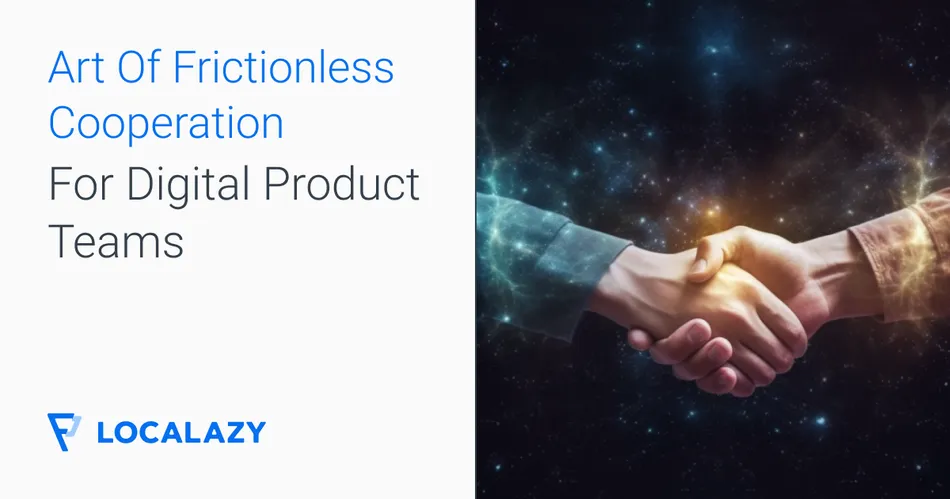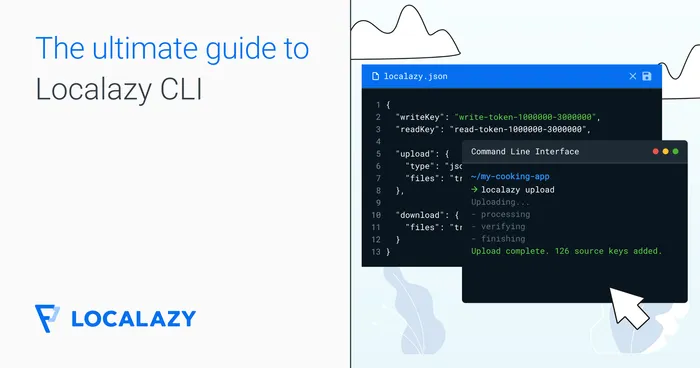Building a digital product is an art as much as it is a science. 👩🎨🧪 With all the tech behind the entire workflows, processes, and teams, it is almost impossible not to encounter a little bit of friction along the way.
Friction slows down everything, like a stick in the wheels. In an ideal world, zero friction would mean zero production obstacles. However, sources of friction are multiple and can't be confined to a process or a tool. You'd be surprised to learn how the idea of friction fits within a daily workflow and how to tackle it.

🕵️ Where Do We Find Friction? 🔗
Software localization and other processes that involve learning, collaboration, and problem-solving skills leave space for friction. Friction can impede personal productivity and obstruct the workflow of your entire digital product team.
Where does friction occur more often? Let's explore some common scenarios and friction points.
During the Learning Curve 🔗
Sometimes, when we're learning new things, it can feel a little tricky. This happens because of what's known as the learning curve. We face it when we're introduced to new tools, technologies, or ways of doing things. Even opening a Gmail account poses friction because the learning curve is steep for someone who has never opened one before. 😩 📩 Friction is found in unfamiliar processes, and it slows down workflows.
However, sometimes, the learning curve gets steep not only because of familiarity with the work process but also because of other elements. For example, the environment is a significant factor. If the place where we're learning or where we are working from is distracting, uncomfortable, or confusing, it makes the process more difficult.
Friction is found in unfamiliarity. However, other elements, as the environment, can slown down processes as well.
So, having a clean and quiet learning environment is a must for a smooth learning and work process. It contributes to a better output for you and your team. It translates directly into more work done and better cooperation. It makes the learning curve shorter and reduces friction immensely.
In Missing Processes, Which Are a Petri Dish for Friction 🔗
Friction occurs in missing or poorly defined processes. You must provide clear guidelines and set proven workflows for your team to produce reasonable results. When these processes are missing, your team members will not only be confused about what they should be doing but will also mix each other's responsibilities.

During Conflicts 🔗
Conflicts are another cause of friction. And these conflicts aren't limited to team conflicts. They can be interpersonal - when a teammate is going through a dark period in their life - or when using tools that complicate the workflow.
Interpersonal Conflict
Interpersonal conflicts occur when a teammate struggles to complete a task because they don't feel confident they can do it or the guidelines are unclear. For example, you've asked your copywriter to write an email that promotes the launch of your affiliate marketing program, but you haven't given them details on the commission that users will get, cookie duration, or where they can track the traffic they bring. They'll typically feel puzzled and wonder if they should ask for these details or write a general email.

Team Conflict
A typical instance is when a product manager may want to implement one particular feature while the development team may side with another approach, leading to delays and indecision. Time is lost, and the shipping process is delayed.
Conflicting Tools
Another example involves the use of conflicting or complicated tools. You could be using a project management software that doesn't offer a proper time-tracking feature, thus forcing your team to manually update a spreadsheet with their working hours. This can lead to productivity and time losses, annoyance, and lots of friction.
💬 To avoid conflict and the friction that arises from it, hold regular team meetings and create a work environment where everyone can express their opinions freely.
Inefficient Processes 🔗
Friction often arises from inefficiencies within collaborative processes. When processes are time-consuming or require excessive effort, friction builds up, impacting the overall efficiency of the collaborative workflow.
These inefficiencies can stem from:
- lack of automation,
- redundant or manual tasks,
- or inefficient use of tools and resources.
🔎 What Should We Seek Instead? 🔗
We should equip ourselves and our teams with the right tools to minimize friction. This will lower it significantly and make it easier to fall into a state of productive work, known as 🌟 the flow state. The flow state leads to high-quality work completed with stellar focus.
When speaking of tools, we should consider both conceptual frameworks and task management systems (like GIST, PARA, Agile, PDCA cycle, etc.) and practical software programs to manage your projects. Some examples here are:
Finding the right software that works for your team is challenging because all tools have different features. So, you must find which software comes with the lowest friction to your daily workflows. And this might require a bit of experimentation.
For instance, at Localazy, we use different pieces of software to manage our projects, communicate internally, and set up our knowledge base. Previously, we were using ClickUp for many months, which provided a wonderful experience, but it led to a few silos we fixed by switching to Fibery.
After the switch, our marketing and product teams are always in sync, and our knowledge base and project management reside now in one place. This reduced friction immensely and improved our workflow efficiency.
Curious about the way we work at Localazy? Check out our latest progress update to get details! 🏄
🪷 When Does The Flow State Occur? 🔗
The flow state occurs when a person is fully immersed in an activity, feeling intensely focused, energized, and deeply involved in the present moment. Psychologist Mihaly Csikszentmihalyi first described this psychological state in the 1970s.
Csikszentmihalyi would explain flow as "a state in which people are so involved in an activity that nothing else seems to matter; the experience is so enjoyable that people will continue to do it even at great cost, for the sheer sake of doing it" (1990).

This flow state typically occurs when certain conditions are met during an activity. These conditions include:
Clear Goals 🔗
Your teammates need to have clear and specific goals providing a sense of direction and purpose for their daily workflow. 🎯 Now, this is no easy feat. How to achieve it? Here are a few tips you should consider:
- Get a clear overview of both short-term and long-term goals for your company.
- Create a strategy with SMART (Specific, Measurable, Achievable, Realistic, and Timely) goals.
- Set reasonable timelines and reward those who deliver early.
- Track the progress and make workload changes if needed.
Matched Challenge and Skill Level 🔗
You should give your teammates tasks that match their level of expertise but are also a bit challenging. They should be neither too easy (leading to boredom) nor too difficult (leading to anxiety). How can you maintain this balance?
Start by understanding your teammates' strengths and weaknesses. Find the intersection between what they're good at and what they like doing more. 💪 Personality tests are a great help. You can consider:
Intense Focus 🔗
Another must-have for the flow state to take place is intense focus. When someone dives into the flow state, they're fully absorbed in the task, with a deep concentration that blocks out distractions and irrelevant thoughts. This can become extremely challenging if you don't limit the distractions in the workplace.
So, how can you support digital product team members to fully focus and prevent distractions from interrupting their flow state? Well, here are some simple things:
- 📲 Text instead of calling when you want to communicate with them.
- 🔇 Limit Slack messages unless it's something necessary,
- 🤫 and maybe buy them a pair of earplugs as a gift to help block out distractions.
Immediate Feedback 🔗
Another factor is that the activity they're doing needs to be provided with immediate and clear feedback, allowing them to adjust their actions and stay engaged. However, this might not be the case for everyone on your team.
Developers and designers can receive fast feedback, as their code or design is visible instantly as they finish the tasks. This is much harder for other professionals, such as marketing campaign managers. For example, seeing the results of a long-term marketing campaign requires time. In that case, marketers shall seek ways to find everyday success and get the feedback loop running. Otherwise, they can burn out and feel uninspired.
Some examples of factors to rely on for immediate feedback in this scenario include:
- The number of campaigns they activate.
- The early analytics results for new campaigns.
- Their input to other departments and the market research performed.

Sense of Control 🔗
During the flow state, your teammates experience a profound sense of control over the task at hand. They zoom in on the task at hand to the point they feel like nothing else exists, and they believe that their actions have a direct impact on the final outcome.
In this state, there's an innate understanding that they are in charge, and this empowerment fuels their motivation and focus. 🏅
Loss of Self-Consciousness 🔗
Another condition to reach the flow state is that the person becomes so involved in the activity that they lose awareness of time, self-consciousness, and concerns about failure. Think about the last time you were listening to a song you really loved. For a moment, the world around you fades into the background. 😌 This is precisely what happens during the flow state.
Self-consciousness, which often makes us rush into worry about being in control of everything, disappears almost entirely. In this state, your teammate feels like an athlete in perfect sync with their every move. It's a moment when they forget their worries and focus on the present moment and on completing their task.
Altered Sense of Time 🔗
When your teammates are in their flow state, work feels effortless, and they don't realize that the time is passing. For as long as no one interrupts them in this state, they might stay in it for hours to come. Hours will feel like minutes during this time.
⚖️ Key: Find The Golden Middle in the Complexity of Each Challenge 🔗
If you want to get immersed into the flow state and help your team do so, the first thing here is to find the perfect balance in task complexity. Just like the flow state experienced by artists and musicians, digital product teams can reach a similar flow state that benefits their performance and helps them become more efficient.
However, it's important not to select a task that is too challenging and demanding, as it will lead to frustration and stress, harming your productivity and efficiency. A task that keeps the golden middle ignites a sense of purpose and motivation.
When your team is in the flow state, they can fully focus on the complexities of the localization process, allowing their creativity and problem-solving skills to reach their peak. When tasks are thoughtfully distributed to strike this balance, localization teams can maintain a steady workflow, avoiding bottlenecks and unnecessary delays.
👩💻 Learn to optimize your localization workflow using Localazy's CLI here.
💪 Increasing Productivity Is a Must for Digital Product Teams 🔗
Improved productivity doesn't only mean that your teams will be able to deliver high-quality products within tight timelines. They'll also be mentally sharp and ready for new challenges. What's a no-brainer approach they should adopt?
- Distributing resources more strategically,
- and using automation tools.
By relying on continuous improvement practices and data-driven insights, teams can identify bottlenecks, address inefficiencies, and fine-tune their processes for optimal results. And the flow state helps them achieve stellar productivity levels.

What Is Productivity in Itself? 🔗
At its core, productivity is the measure of how effectively resources, time, and efforts are used to reach certain goals. When we talk about productive work, we're not talking only about quantity but more about the quality of the produced work.
The Cambridge Academic Content Dictionary defines productivity as: the rate at which a person, company, or country does useful work.
While there are multiple definitions of productivity, this is all-inclusive. In workflow terms, we can say that productivity is about maximizing results while minimizing inefficiencies. It means making more strategic decisions, prioritizing tasks, and arranging processes to achieve the best possible outcome in a given timeframe.
At Localazy, we follow a modern approach to solving your localization problems by providing diverse solutions. Our platform is equipped for developers and non-developers alike and can be navigated seamlessly to optimize your workflow.
📌 Final Thoughts 🔗
If you help your team achieve the flow state daily, you'll help them complete more high-quality work. 💡 While this isn't always easy, as long as you contribute by distributing the right tasks, choosing frameworks and software that work for everyone, and creating a distraction-free workplace, you're likely to get there.
Our platform is easy to use and makes your localization process smooth and fast. We aim to eliminate the barriers of language and cultural differences and support your teams in doing what they do best—creating exceptional digital products.




